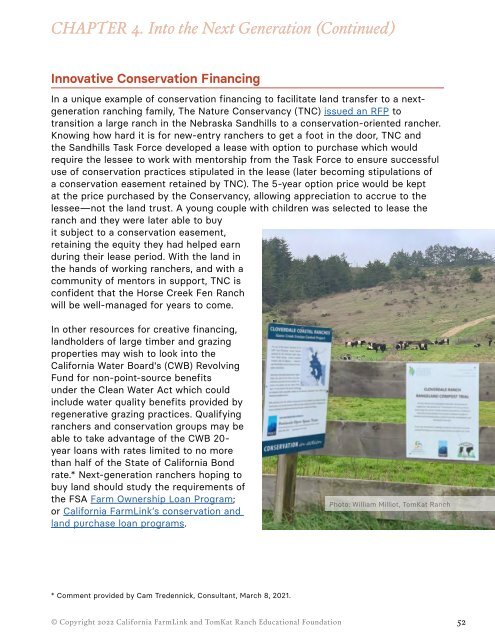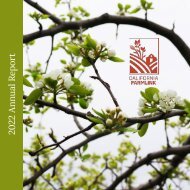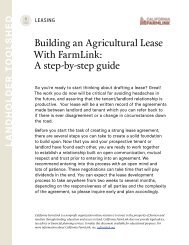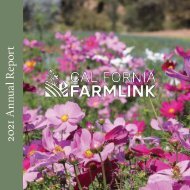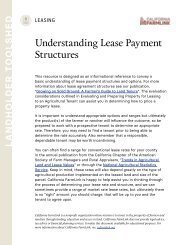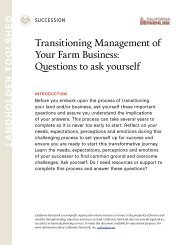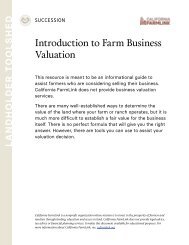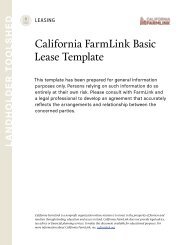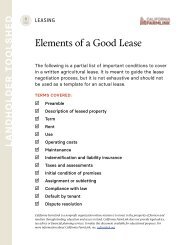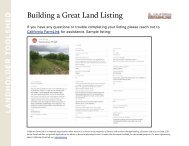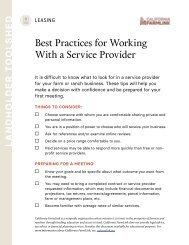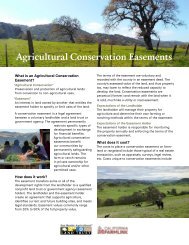Guide to Regenerative Grazing Leases: Opportunities for Resilience
California FarmLink and TomKat Ranch Educational Foundation teamed up to create this resource focused on land leases that support regenerative grazing practices. This guidebook aims to empower private, nonprofit, and public landholders, as well as easement-holders and grazing tenants.
California FarmLink and TomKat Ranch Educational Foundation teamed up to create this resource focused on land leases that support regenerative grazing practices. This guidebook aims to empower private, nonprofit, and public landholders, as well as easement-holders and grazing tenants.
You also want an ePaper? Increase the reach of your titles
YUMPU automatically turns print PDFs into web optimized ePapers that Google loves.
CHAPTER 4. In<strong>to</strong> the Next Generation (Continued)<br />
PASSING DOWN THE RANCH<br />
A healthy, regenerative system is built <strong>for</strong> the long haul. The current generation<br />
grazing your land may have another ten, twenty, or more years of grass-growing,<br />
soil-building, and ecological web-weaving ahead. But then what? Too often, ranchers<br />
and landholders fail <strong>to</strong> plan <strong>for</strong> the inevitable changes that life brings—and end<br />
up in crisis with no one <strong>to</strong> take<br />
over. Even when there is a willing<br />
and chosen successor, transition<br />
challenges can be <strong>for</strong>midable.<br />
Ranching, like all of agriculture,<br />
is facing an unprecedented<br />
succession crisis due <strong>to</strong> a number<br />
of fac<strong>to</strong>rs: high costs of entry in<strong>to</strong><br />
the business of ranching, lack of<br />
secure and af<strong>for</strong>dable land tenure,<br />
regula<strong>to</strong>ry burdens, and marginal<br />
profitability <strong>for</strong> even ‘successful’<br />
businesses.<br />
Pho<strong>to</strong>: Liya Schwartzman<br />
“Traditionally, ranching has been a closed-door industry,” writes Madeline Jorden in<br />
Ranchlands Review. “The high costs of entering agriculture are significant enough <strong>to</strong><br />
prevent young people from choosing it as a career, while families who do pass down<br />
an agricultural operation are threatened by the opportunity <strong>for</strong> higher wages in urban<br />
areas that are drawing the next generation away from the land. All in all, ... [this] does<br />
much <strong>to</strong> stifle innovation.”<br />
An af<strong>for</strong>dable, secure lease can be just the leg up needed <strong>for</strong> a promising nextgeneration<br />
grazier <strong>to</strong> make the leap in<strong>to</strong> ranching as a livelihood.<br />
Cali<strong>for</strong>nia FarmLink has worked with farmers, ranchers, landholders, at<strong>to</strong>rneys,<br />
and others <strong>to</strong> create a trove of resources designed <strong>to</strong> help families transition their<br />
farm or ranch land and businesses. These include lease templates, asset purchase<br />
agreements and <strong>to</strong>ols, a grazing contract, a land tenure guidebook, a farm/<br />
ranch succession guidebook, a collection of case studies on how land trusts can<br />
improve land access <strong>for</strong> farmers, and more. In 2021, FarmLink launched a 12-month<br />
succession program <strong>for</strong> farming and ranching families, The Regenera<strong>to</strong>r: A Year of<br />
Farm Succession Planning.<br />
© Copyright 2022 Cali<strong>for</strong>nia FarmLink and TomKat Ranch Educational Foundation<br />
50


